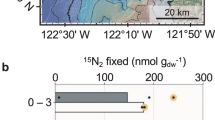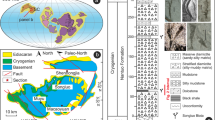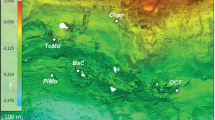Abstract
The disappearance of iron formations from the geological record ∼1.8 billion years (Gyr) ago was the consequence of rising oxygen levels in the atmosphere starting 2.45–2.32 Gyr ago1,2,3. It marks the end of a 2.5-Gyr period dominated by anoxic and iron-rich deep oceans. However, despite rising oxygen levels and a concomitant increase in marine sulphate concentration, related to enhanced sulphide oxidation during continental weathering4, the chemistry of the oceans in the following mid-Proterozoic interval (∼1.8–0.8 Gyr ago) probably did not yet resemble our oxygen-rich modern oceans. Recent data5,6,7,8 indicate that marine oxygen and sulphate concentrations may have remained well below current levels during this period, with one model indicating that anoxic and sulphidic marine basins were widespread, and perhaps even globally distributed4. Here we present hydrocarbon biomarkers (molecular fossils) from a 1.64-Gyr-old basin in northern Australia, revealing the ecological structure of mid-Proterozoic marine communities. The biomarkers signify a marine basin with anoxic, sulphidic, sulphate-poor and permanently stratified deep waters, hostile to eukaryotic algae. Phototrophic purple sulphur bacteria (Chromatiaceae) were detected in the geological record based on the new carotenoid biomarker okenane, and they seem to have co-existed with communities of green sulphur bacteria (Chlorobiaceae). Collectively, the biomarkers support mounting evidence for a long-lasting Proterozoic world in which oxygen levels remained well below modern levels.
This is a preview of subscription content, access via your institution
Access options
Subscribe to this journal
Receive 51 print issues and online access
$199.00 per year
only $3.90 per issue
Buy this article
- Purchase on Springer Link
- Instant access to full article PDF
Prices may be subject to local taxes which are calculated during checkout



Similar content being viewed by others
References
Holland, H. D. in Treatise on Geochemistry Vol. 6 (The Oceans and Marine Geochemistry (ed. Elderfield, H.) 583–625 (Elsevier/Pergamon, Oxford, 2004)
Farquhar, J., Bao, H. & Thiemens, M. Atmospheric influence of Earth's earliest sulfur cycle. Science 289, 756–758 (2000)
Bekker, A. et al. Dating the rise of atmospheric oxygen. Nature 427, 117–120 (2004)
Canfield, D. E. A new model for Proterozoic ocean chemistry. Nature 396, 450–453 (1998)
Shen, Y., Canfield, D. E. & Knoll, A. H. Middle Proterozoic ocean chemistry: evidence from the McArthur Basin, northern Australia. Am. J. Sci. 302, 81–109 (2002)
Shen, Y., Knoll, A. H. & Walter, M. R. Evidence for low sulphate and anoxia in a mid-Proterozoic marine basin. Nature 423, 632–635 (2003)
Kah, L. C., Lyons, T. W. & Frank, T. D. Low marine sulphate and protracted oxygenation of the Proterozoic biosphere. Nature 431, 834–838 (2004)
Arnold, G. L., Anbar, A. D., Barling, J. & Lyons, T. W. Molybdenum isotope evidence for widespread anoxia in mid-Proterozoic oceans. Science 304, 87–90 (2004)
Page, R. W. & Sweet, I. P. Geochronology of basin phases in the western Mt Isa Inlier, and correlation with the McArthur Basin. Aust. J. Earth Sci. 45, 219–232 (1998)
Bull, S. W. Sedimentology of the Palaeoproterozoic Barney Creek Formation in DDH BMR McArthur 2, southern McArthur Basin, Northern Territory. Aust. J. Earth Sci. 45, 21–31 (1998)
Jackson, M. J., Southgate, P. N., Winefield, P. R., Barnett, K. & Zeilinger, I. Revised sub-devision and regional correlation of the McArthur Basin succession based on NABRE's 1995–8 sequence stratigraphic studies (Australian Geological Survey Organization, record 2000/03, Canberra, 2000).
Veizer, J., Plumb, K. A., Clayton, R. N., Hinton, R. W. & Grotzinger, J. P. Geochemistry of Precambrian carbonates: V. Late Paleoproterozoic seawater. Geochim. Cosmochim. Acta 56, 2487–2501 (1992)
Crick, I. H., Boreham, C. J., Cook, A. C. & Powell, T. G. Petroleum geology and geochemistry of Middle Proterozoic McArthur Basin, northern Australia. II: Assessment of source rock potential. AAPG Bull 72, 1495–1514 (1988)
Summons, R. E., Powell, T. G. & Boreham, C. J. Petroleum geology and geochemistry of the Middle Proterozoic McArthur Basin, northern Australia: III. Composition of extractable hydrocarbons. Geochim. Cosmochim. Acta 52, 1747–1763 (1988)
Summons, R. E. & Jahnke, L. L. in Biological Markers in Sediments and Petroleum (eds Moldowan, J. M., Albrecht, P. & Philp, R. P.) 182–200 (Prentice Hall, Englewood Cliffs, New Jersey, 1992)
Collister, J. W., Summons, R. E., Lichtfouse, E. & Hayes, J. M. An isotopic biogeochemical study of the Green River oil shale. Org. Geochem. 19, 265–276 (1992)
Hoehler, T. M., Alperin, M. J., Albert, D. B. & Martens, C. S. Thermodynamic control on hydrogen concentrations in anoxic sediments. Geochim. Cosmochim. Acta 62, 1745–1756 (1998)
Scholten, J. C. M. et al. Effect of sulfate and nitrate on acetate conversion by anaerobic microorganisms in a freshwater sediment. FEMS Microbiol. Ecol. 42, 375–385 (2002)
Hayes, J. M., Lambert, I. B. & Strauss, H. in The Proterozoic Biosphere: A Multidisciplinary Study (eds Schopf, J. W. & Klein, C.) 129–134 (Cambridge Univ. Press, New York, 1992)
Summons, R. E., Jahnke, L. L., Hope, J. M. & Logan, G. A. 2-Methylhopanoids as biomarkers for cyanobacterial oxygenic photosynthesis. Nature 400, 554–557 (1999)
Palmisano, A. C., Cronin, S. E. & Des Marais, D. J. Analysis of lipophilic pigments from a phototrophic microbial mat community by high performance liquid chromatography. J. Microbiol. Methods 8, 209–217 (1988)
Volkman, J. K. Sterols in microorganisms. Appl. Microbiol. Biotechnol. 60, 496–506 (2003)
Bird, C. W. et al. Steroids and squalene in Methylococcus capsulatus grown on methane. Nature 230, 473–474 (1971)
Brocks, J. J. & Summons, R. E. in Treatise on Geochemistry Vol. 8 (Biogeochemistry) (ed. Schlesinger, W. H.) 63–115 (Elsevier, Oxford, 2004)
Van Gemerden, H. & Mas, J. in Anoxygenic Photosynthetic Bacteria (eds Blankenship, R. E., Madigan, M. T. & Bauer, C. E.) 49–85 (Kluwer Academic, Dordrecht, 1995)
Repeta, D. J., Simpson, D. J., Jørgensen, B. B. & Jannasch, H. W. Evidence for the existence of anoxygenic photosynthesis from the distribution of bacteriochlorophylls in the Black Sea. Nature 342, 69–72 (1989)
Kara, A. B., Rochford, P. A. & Hurlburt, H. E. Mixed layer depth variability over the global ocean. J. Geophys. Res. 108(C3), 3079 (2003) (doi:10.1029/2000JC000736)
van Kaam-Peters, H. M. E. & Sinninghe Damsté, J. S. Characterization of an extremely organic sulphur-rich, 150 Ma old carbonaceous rock: palaeoenvironmental implications. Org. Geochem. 27, 371–397 (1997)
Schaeffer, P., Adam, P., Wehrung, P. & Albrecht, P. Novel aromatic carotenoid derivatives from sulfur photosynthetic bacteria in sediments. Tetrahedr. Lett. 38, 8413–8416 (1997)
Anbar, A. D. & Knoll, A. H. Proterozoic ocean chemistry and evolution: a bioinorganic bridge? Science 297, 1137–1142 (2002)
Acknowledgements
We thank J. Hope, C. Sandison and P. Greenwood for technical support; A. Bradley and R. Haese for scientific expertise on methanogens; Geoscience Australia (GA) and the Northern Territory Geological Survey for samples; D. Rawlings for expert advice on the geology of the McArthur Group; and P. Schaeffer for supplying synthetic standards of aromatic carotenoids. This work was supported by the William F. Milton Fund of Harvard University and GA. Work conducted at Massachusetts Institute of Technology was supported by a NASA Exobiology grant to R.E.S. G.D.L. and S.A.B. were at the University of Newcastle upon Tyne during parts of the preparation of this work and thank the Natural Environment Research Council for funding a postdoctoral fellowship and PhD studentship, respectively. J.J.B. acknowledges the Harvard Society of Fellows and the Department of Organismic & Evolutionary Biology, Harvard University, for financial support during the preparation of this work.
Author information
Authors and Affiliations
Corresponding author
Ethics declarations
Competing interests
Reprints and permissions information is available at npg.nature.com/reprintsandpermissions. The authors declare no competing financial interests.
Supplementary information
Supplementary Notes
Supplementary Methods (information about sample preparation and analysis), Supplementary Discussion (a short review of biological origins of aromatic carotenoids), Supplementary Table S1 (Presence of arylisoprenoids in samples from the Barney Creek Formation), and the chemical structures of relevant biomarkers. (DOC 268 kb)
Rights and permissions
About this article
Cite this article
Brocks, J., Love, G., Summons, R. et al. Biomarker evidence for green and purple sulphur bacteria in a stratified Palaeoproterozoic sea. Nature 437, 866–870 (2005). https://doi.org/10.1038/nature04068
Received:
Accepted:
Issue Date:
DOI: https://doi.org/10.1038/nature04068
This article is cited by
-
Soft-sediment deformation structures or microbially induced sedimentary structures: the description and possible origin of the "loopites" in the Mesoproterozoic Wumishan Formation, North China
Carbonates and Evaporites (2024)
-
Late acquisition of the rTCA carbon fixation pathway by Chlorobi
Nature Ecology & Evolution (2023)
-
Lost world of complex life and the late rise of the eukaryotic crown
Nature (2023)
-
Early Cretaceous marine incursions into South Atlantic rift basins originated from the south
Communications Earth & Environment (2023)
-
Sterol methyltransferases in uncultured bacteria complicate eukaryotic biomarker interpretations
Nature Communications (2023)
Comments
By submitting a comment you agree to abide by our Terms and Community Guidelines. If you find something abusive or that does not comply with our terms or guidelines please flag it as inappropriate.



